The Greek Pythagoras was known mainly for his discoveries and creations on mathematics.
But there is a fascinating story regarding his research on musical notes. Pythagoras wanted to see if
there was a way to relate musical notes with string lengths. He made the fascinating discovery that it was the
simplest fractions of the original string length that produced the most consonant - or pleasing - sounds.
I discuss his findings below. My intention is to provide one of the simplest and (hopefully) most understandable
presentation possible. For this reason I won't be switching between "fractions" and "ratios", like most of the
numerous articles I've read. It'll be just fractions.
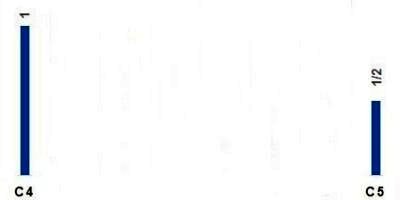 |
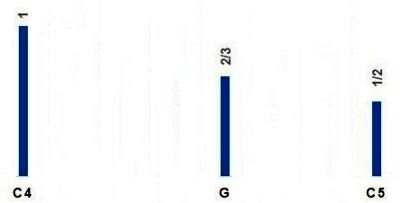 |
1) Pythagoras first tried (probably not for long) comparing
the original string length's sound to itself (the "Unison"). Pluck the string and then pluck it again, and/or pluck two strings
of the same length at the same time. |
2) The next thing Pythagoras did was to look
or the next simplest fraction. He already did 1/2, so the next thing fraction to try was 2/3. He found that,
whereas the sound of the 1/2 length string was "similar" to the sound of the full length string, the sound of
this string plucked by itself was "different". Also, playing the original string along with one that was 2/3 of its
length also produced a more consonant sound. But this combined sound was far more interesting! "But what about 1/3?", you might ask. Isn't that "simpler" than 2/3? All the articles about Pythagoras that I've seen leave out 1/3 (and 1/4). Why is that?? Well, I'll discuss this below. Here's the C4, the G, and then the two notes combined. 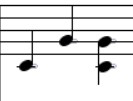
|
|
Here's the C4, followed by the C5, followed by both played together. The instrument is a Lyon and Healy harp - from the Garritan Harps collection. 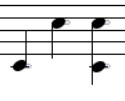
|
|
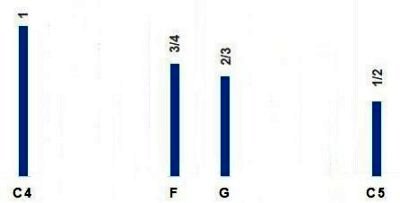 |
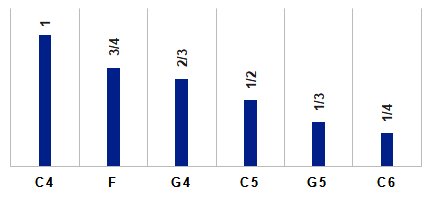 |
3) "What's next?", the Pi Man asked. He tried 3/4, and found that it, too,
provided a consonant tone when played with the original string. It wasn't as powerful and primal
as the perfect fifth, but was still better than any combination of strings involving fractions more
"complex" than 1/2, 2/3, and 3/4. And what about 1/4 (and 1/3)? See the next panel. Here's the C4, the F, and then the two notes combined. 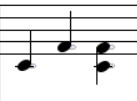
|
4) So THIS shows why 1/3 and 1/4 were not used in deciding what fractions should
be used as the simplest ones based on the original string. It turns out that 1/3 and 1/4 of the original
string produced notes that were contained in higher octaves. The wavelength of C4 is 131.87 1/3 of 131.87 yields 43.9, which is the wavelength of the G5 that is above C5. 1/4 of 131.87 yields 32.96, which is the wavelength of C6 which is one octave above C5, and 2 octaves above the original C4. So perhaps Pythagoras, upon hearing that these two new notes were "higher" than C5,
concluded that these two notes were "out of range" of the original octave from C4 to C5. So perhaps he
simply decided to use 1 minus 1/3, or 2/3, and 1 minus 1/4, or 3/4 as the next simplest fractions between
1/2 and 1. 2/3 of 131.87 yields 98.9, which is the wavelength of the modern note G (above C4). 3/4 of 131.87 yields 87.9, which is the wavelength of the modern note F, above C4 |
|
And here is: C4, then G5, back to G4, followed by C4, then C6, back to F4 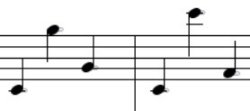
|
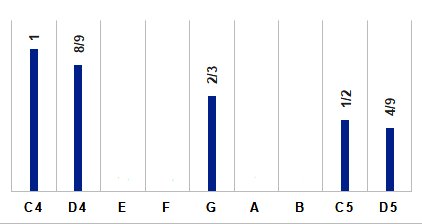 |
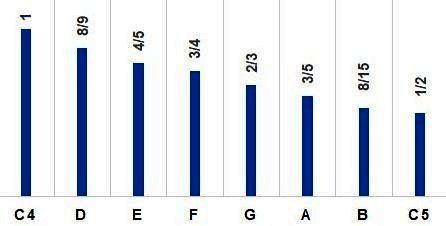 |
5) So, as of section 3 above, we (and Pythagoras) have 4 notes: C4 (representing string length 1), F (3/4 of the original string length - the "Perfect Fourth"), G (2/3 of the original string length - the "perfect Fifth"), C5 (1/2 of the original string length - the "Octave"), So how did Pythagoras derive the remaining fractions, in his efforts to show that music was somehow
related to basic - or relatively basic - fractions? So we take 2/3 of G. To do this we multiply "G" (which is 2/3 of the original string) by 2/3. That is, we are finding the "perfect fifth" of G. On a modern piano keyboard, this is 5 notes above the G. So 2/3 X 2/3 gives us 4/9, which is D5 in the above image. To move the D back to the original octave, we multiply by 2. This gives us 8/9, which became the (relatively) simple fraction that Pythagoras associated with D. This is D4. "How did the Pi Man know this?", you might ask. Perhaps by comparing sounds with existing instruments. But we can verify using modern concepts. Thus G (wavelength 88.01) X 2/3 is 58.67. This is the wavelength of D5 that is one octave up. To move it back to the original octave, multiply by 2, and we get 117.34, which is D4 in the original octave. This just might be the origin of the "Circle of Fifths", which has to be the most confusing diagram on the planet! And here is: C4, then D5, back to D4, followed by the sequence C4, D4, G, C5 
|
6) In the image above, we see the 7 notes of
the diatonic collection. The fractions that are shown represent what are believed to be the original ones
that Pythagoras came up with. We now take our D (8/9) and multiply by 2/3. So 2/3 X 8/9 = 16/27. This fraction can't be simplified, but it's "close" to 15/25, which simplifies to 3/5. This creates the note "A". As a "sanity check", 16/27 is .5926, and 3/5 is .60. Sound a bit sloppy? It is, but it is well to note that while our musical notes are fairly precise today, the diatonic scales back in Pythagoras' time were highly variable, and were said to be different even from one city to another. Now we take our A (3/5) and multiply by 2/3, yielding 6/15, which simplifies to 2/5, which is E in the next octave. Multiply by 2 and we get 4/5, the "E" in the original octave. Finally, we multiply E (4/5) by 2/3 and we get 8/15, or "B". We can check all this using the "modern" wavelengths of the various notes. (Remember that all modern notes have been "adjusted" from Pythagoras' time, to provide equal spacing between notes. So these numbers differ slightly from those you might calculate using the Pythagoran fractions.) So G (wavelength 88.01) X 2/3 is 58.67, which is D, but one octave up. So multiply by 2 and we get 117.34, which is D in the original octave. Now we take D (wavelength 117.34) X 2/3 is 78.23, which is A in the original octave. Now we take A (78.23) X 2/3 is 52.15 which is E, but one octave up, So multiply by 2 and we get 104.31, and we get E in the original octave. And finally we take E (104.31) X 2/3 and we get 69.77, which is B. |
|
And finally, the entire "C major pitch collection" 
|
Another excellent summary on the origins of musical notes can be found here:
Where Does the 12-Tone Scale Come FromAnd here's "Jimmie's Diatonic Chart". Each line shows:
The note name for each note, or "scale degree"
The Pythagoran string fraction
The frequency, as adjusted for modern notes. The frequency doubles for any octave, E.G.: C to C, G to G, etc.
The wavelength, as adjusted for modern notes. The wavelength is halved from octave to octave.
NOTE |
Note Name |
String Length |
Frequency |
Wavelength |
C4 |
Tonic |
1 |
261.63 |
131.87 |
D |
Supertonic |
8/9 |
293.66 |
117.48 |
E |
Mediant |
4/5 |
329.63 |
104.66 |
F |
Subdominant |
3/4 |
349.23 |
98.79 |
G |
Dominant |
2/3 |
392.0 |
88.01 |
A |
Submediant |
3/5 |
440.0 |
78.41 |
B |
Leading Tone |
8/15 |
493.88 |
69.85 |
C5 |
Octave |
1/2 |
523.25 |
65.93 |
D-F |
|
|
|
|
G |
Pf 5th oct |
1/3 |
783.99 |
44.01 |
A-B |
|
|
|
|
C6 |
Octave |
1/4 |
1046.5 |
32.97 |
As a final note, string lengths and the resulting musical notes are proportional, for "simple" strings. If you pluck a string and then hold your finger in the middle and pluck one of the halves, you will get a note an octave higher. So you could potentially make a simple string instrument using these simple fractions.
So, you wanna' make your own harp? Then you need Gamut Strings' site:
Gamut Strings Quick CalculatorBut the string proportionality is not true of pipes. Thus if you were making wind chimes, you can't just cut a pipe until it sounds like "C" and then cut another pipe 2/3 that length in order to get "G". There are actually charts for cutting pipes, and their lengths are not simple proportions like those of strings. The lengths even change for different metals and/or different wall thicknesses.
What? You want to make wind chimes instead? Then you need Lee Hite's site:
Lee Hite's Say It With ChimesCopyright © 2020 J.A.